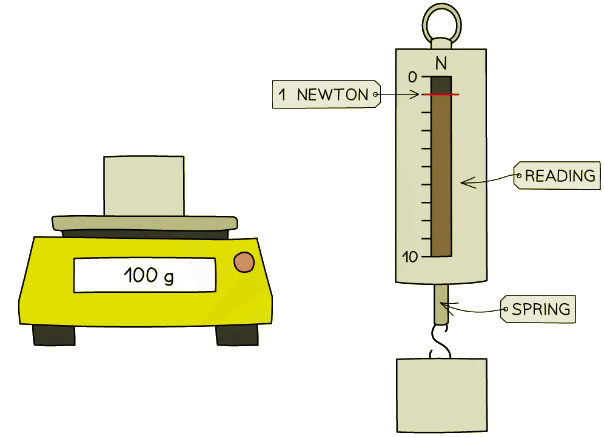Grade 10 Exam > Grade 10 Notes > Physics for Grade 10 > Weight, Mass & Gravity
Weight, Mass & Gravity | Physics for Grade 10 PDF Download
Defining Weight
- Weight is defined as:
- The force acting on an object due to gravitational attraction
- Planets have strong gravitational fields
- Hence, they attract nearby masses with a strong gravitational force
- Because of weight:
- Objects stay firmly on the ground
- Objects will always fall to the ground
- Satellites are kept in orbit
 Some of the phenomena associated with gravitational attraction and the weight force
Some of the phenomena associated with gravitational attraction and the weight force
- Mass (measured in kilograms, kg) is related to the amount of matter in an object
- The more mass an object has the larger the weight force it will experience
- Since weight is a force, it is measured in Newtons (N)
- The weight that an object experiences depends on:
- The object's mass
- The mass of the planet attracting it
Measuring Weight
- Mass is commonly measured using a top pan balance
- The weight can then be indirectly found through calculation
- Weight can be measured directly using a calibrated spring-balance, also known as a newton-meter
- This device is a type of weighing scale which measures force in Newtons
- It consists of a spring fixed at one end with a hook to attach an object at the other
 Weight can be measured using a top-pan balance or a newton-meter
Weight can be measured using a top-pan balance or a newton-meter
Tip: Since mass is measured in kilograms in Physics, if it is given in grams make sure to convert to kg by dividing the value by 1000!
Centre of Mass
- The centre of mass of an object (sometimes called the centre of gravity) is defined as:
- The point through which the weight of an object acts
- For a symmetrical object of uniform density, the centre of mass is located at the point of symmetry
- For example, the centre of mass of a sphere is at the centre
 The centre of mass of a regular shape can be found by symmetry
The centre of mass of a regular shape can be found by symmetry
- For example, the centre of mass of a sphere is at the centre
- The centre of mass of an irregular object can be found by locating its balance point
- A broomstick has a centre of mass slightly closer to the head of the broom since there is more mass located there
 The centre of mass of a broomstick which is also its balance point
The centre of mass of a broomstick which is also its balance point
- A broomstick has a centre of mass slightly closer to the head of the broom since there is more mass located there
Tips: Since the centre of mass is a hypothetical point, it can lie inside or outside of a body. The centre of mass will constantly shift depending on the shape of a body. For example, a human body’s centre of mass is lower when learning forward than when stood upright.
However, make sure that when you are drawing force diagrams to draw the forces as if they were acting on the centre of mass of the object!
The document Weight, Mass & Gravity | Physics for Grade 10 is a part of the Grade 10 Course Physics for Grade 10.
All you need of Grade 10 at this link: Grade 10
|
124 videos|149 docs|37 tests
|

|
Explore Courses for Grade 10 exam
|

|
Signup for Free!
Signup to see your scores go up within 7 days! Learn & Practice with 1000+ FREE Notes, Videos & Tests.
Related Searches




















